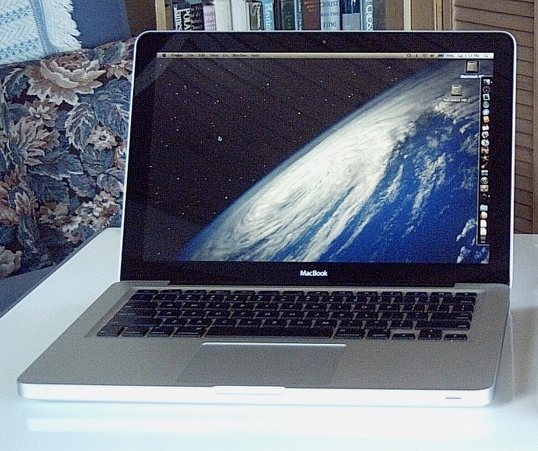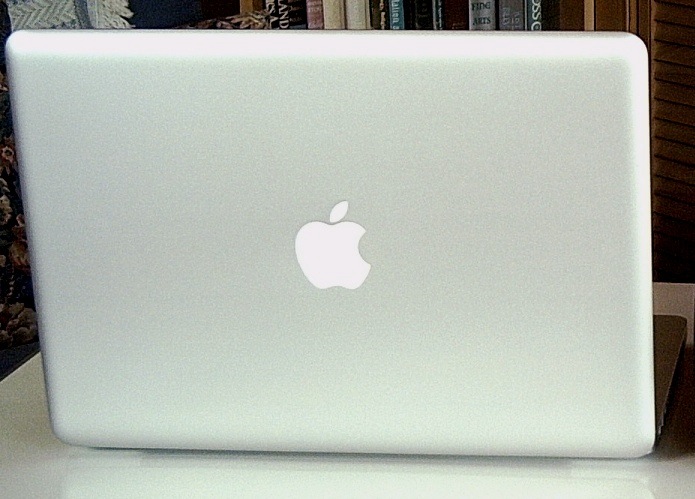The ‘Book Mystique: Unibody MacBook A Delightful Machine
Wednesday, April 1, 2009
by Charles W. Moore
The ‘Book Mystique: Unibody MacBook A Delightful Machine
After a slow start getting it configured satisfactorily, I’m now into my third week using my new 2.0 GHz unibody MacBook as my production workhorse and I’m liking it a lot.

The machine has so far proved a new high water mark for stability - and my G4 PowerBook and Pismos are tough acts to follow in that department, but I lasted just over two weeks in full production mode before memory swap file access built up to a point where the machine bogged down obligating a restart. I’ve been rarely able to last much more than a week with the G4 PowerBook, which has 1.5 GB of RAM. The MacBook still has only its standard 2 GB, of which some gets bled off to support the Nvidia GeForce 9400M integrated graphics support and of course the Intel version of Leopard is somewhat more RAM-hungry, so I’m happily surprised at how well things are going with the relatively modest RAM configuration. I do still plan to upgrade to at least 4 GB (the full 6 GB would be nice) when my wallet recovers a bit.
(Note our exclusive MacPrices coupon: 3% off 13" MacBooks through April 30, 2009, up to $164 off MSRP, prices start at $884 - details here)
In the meantime, the MacBook seems reasonably comfortable running my suite of production applications with the standard 2 GB, and it definitely feels like it’s breathing easier than the G4 PowerBook with 1.5 GB of memory has for the past year or so. I expect that the faster processor and video accelerator contribute to that impression, and that the 5400 RPM hard drive (as opposed to the 4200 RPM unit in the PowerBook) helps as Well. On the other hand, I’m not experiencing nearly the speed boost I anticipated over performance I was getting with the 1.33 GHz G4, and I’m guessing that adding more RAM should speed things up somewhat. The Core 2 Duo is of course quite lively, but at least for the sort of stuff I mostly do, so was the old G4. Things like booting and (some) application launches are noticeably quicker, but as noted I don’t reboot very often. With regard to speed, my main bottleneck was never really application performance anyway but rather the agonizingly slow rural dial-up access to the Internet I’m stuck with, and the MacBook has done nothing to speed that up. In fact, at the seat-of-the pants level, throughput with the external modem feels slower than with the built-in modems in my PowerBook G4 and G4-upgraded Pismos. A timely development has been Opera’s public preview release of their new Opera Turbo browser technology last week. Turbo a proxy server-side optimization and compression technology that Accelerator speeds up data transfer over slow networks like mine by proxy server compression that reduces the volume of data that needs to be downloaded in order to view Web pages by up to 80%, thereby providing significant improvement in browsing speeds over limited-bandwidth connections. Turbo it is mainly targeted to mobile and smartphone users on slow WiFi connections, but it’s a really almost revolutionary innovation for home and office Internet users stuck with dial-up service.
Since Opera was already my favorite browser, it’s been no hardship using it. The software is alpha-quality at this point, and has some raggedy edges and compatibility problems on a few sites, but the increase in speed is nothing short of dramatic, especially if I turn the images off altogether, and it’s free.
Opera says Turbo will be part of future desktop versions of their Opera browser, and I can’t wait for a fully debugged final version to be released.
You can watch turbo in action in a video linked from the Turbo blog site:
http://labs.opera.com/news/2009/03/13/
The Opera Turbo preview can be downloaded from:
http://labs.opera.com/downloads/
There have been some adjustments and annoyances of course. I anticipated some inconvenience going down from the 17” PowerBook display to the 13’3” MacBook, and so it has proved, although the super-bright and instant-on LED screen backlighting have helped mitigate the transition. I’m finding the glossy finish a non-issue for me and like it fine.
My biggest gripes are that I can’t get Eudora 6.2.4 to work on the Intel machine -- at least through the MacBook’s Apple USB dongle modem over my dial-up Internet connection -- and I am missing FireWire as much as I expected to, which is considerably. USB 2 really is a sorry substitute for FireWire.

On the email front, I’m using Mozilla Thunderbird, but not happily. many routine tasks that were so easy and slick with Eudora take more steps and are more tedious with Thunderbird for serious workaday use, and I’m missing Eudora a lot. I don’t like the 3-box user interface motif that Thunderbird shares with most other contemporary POP 3 email clients, and I don’t like Apple Mail either. Thunderbird gets the nod for now partly because it at least has its own dedicated address book rather than having to use the OS X Address Book for contacts as you’re obliged to do with Mail. I’ve never found the OS X Address Book very convenient, and much prefer Eudora’s implementation and its minimalist interface.
The unibody MacBook’s keyboard is not bad, but I still much prefer the keyboards in my Pismo and WallStreet PowerBooks, which remain the all-time benchmark for excellence in computer keyboard feel and comfort. I’m not blown away by the oversized glass “buttonless” trackpad, but it’s serviceable and the lack of a separate button isn’t as aggravating as I expected it to be, and I’ll give it full marks for being more comfortable than the objectionably stiff trackpad buttons in the Pismo and WallStreet.
The built in input devices are a secondary consideration for the sort of use this MacBook will be applied to anyway, since most of the time it will be on a laptop stand hooked up to my trusty Kensington SlimType keyboard and a Logitech V-550 wireless mouse, so the keyboard feel and multitouch trackpad feature aren’t entering into the equation a while lot for now.
I like magnetic MagSafe power adapter plug a lot, although it rankles that Apple has thus far refused to license the technology to third-party suppliers.
The MacBook runs somewhat hotter than the G4 PowerBook did, but so far the cooling fan has not cut in even once in the seven weeks since the computer arrived here -- even when the processor temperature spiked to 80° C during some multitasking with a Time Machine backup in progress, I would be interested in knowing where the fan kick-in threshold is, since it’s obviously considerably higher than the 58.5° C where the PowerBook’s fans started caterwauling. By comparison, the MacBook is blessedly silent, with a wonderfully subdued hard drive and as noted no fan racket to contend with so far.

I also just love the look and feel of this MacBook - the unibody design being the best-looking Apple ‘Book yet with its beautiful “just right” proportions and fine watch standard of finish. To my sense of aesthetics it’s by far the best-looking of the four (counting the MacBook Air) unibodies. Sort of like the PowerBook 5300 and 12” dual USB iBook had sort of “golden mean” proportions, but the larger PowerBook 3400 and 14” iBook that were scaled up from them were ugly duckling homely and somewhat ungainly respectively. I think the 15” and 17” unibodies fare better in the looks department than those machines, but the 13-incher is the pick of the litter in terms of looks.
The MacBook also light and comfortable to carry so there’s a certain irony in that the big 17” G4 PowerBook will now become my “road” Mac once I get around to replacing its battery, which is on its proverbial last legs. I do have a nice Waterfield Racer X case for the 17-incher, which makes it quite comfortable to pack around.
“Delightful” is an apropos descriptor for this computer. I’m a long way from being able to rate it as a favorite or otherwise among the Macs I’ve owned over the years. Reliability is a big component of that, so it will take a year or more before I’m ready to make even a provisional judgment, but it has the earmarks of a very strong candidate to join the Pismos and the 17” PowerBook at the top of my hit parade. I’ve never been able to decide which of those I liked better, and this MacBook has strong potential to complicate the matter further.
Note: Letters to PowerBook Mystique Mailbag may or may not be published at the editor's discretion. Correspondents' email addresses will NOT be published unless the correspondent specifically requests publication. Letters may be edited for length and/or context.
Opinions expressed in postings to PowerBook Mystique MailBag are owned by the respective correspondents and not necessarily shared or endorsed by the Editor and/or PowerBook Central management.
If you would prefer that your message not appear in PowerBook Mystique Mailbag, we would still like to hear from you. Just clearly mark your message "NOT FOR PUBLICATION," and it will not be published.
CM